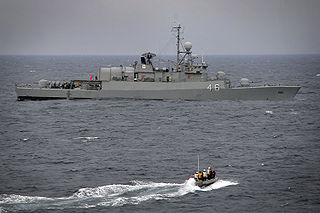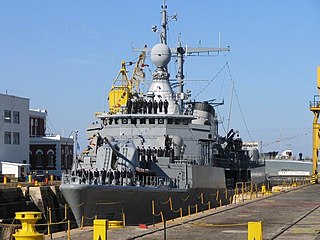
The Argentine Navy is the navy of Argentina. It is one of the three branches of the Armed Forces of the Argentine Republic, together with the Army and the Air Force.

Port Belgrano Naval Base is the largest naval base of the Argentine Navy, situated next to Punta Alta, near Bahía Blanca, about 560 km (348 mi) south of Buenos Aires. It is named after the brigantine General Belgrano which sounded the area in late 1824.

ARA Sarandí is the fourth and last ship of the MEKO 360H2 series of destroyers built for the Argentine Navy. The ship is also the fourth ship in the Argentine Navy to bear that name. Sarandí is the name of a victory of the Argentine army during the Cisplatine War.

ARA Espora (P-41) is the lead ship of the MEKO 140A16 Espora class of six corvettes built for the Argentine Navy. Commissioned in 1985, she is used for fishery patrol. She is homeported at Puerto Belgrano Naval Base and is part of the Navy's 2nd Corvette Division with her five sister ships. The ship is the sixth ship to bear the name of Colonel (Navy) Tomás Espora, who fought in the Argentine Navy during the Cisplatine War. Generator failure left her stranded in South Africa for 73 days in late 2012.

ARA Rosales (P-42) is the second ship of the MEKO 140A16 Espora class of six corvettes built for the Argentine Navy. The ship is the fourth ship to bear the name of Colonel (Navy) Leonardo Rosales, who fought in the Argentine Navy during Argentina's war of independence and the Cisplatine War.

ARA Spiro (P-43) is the third ship of the MEKO 140A16 Espora class of six corvettes built for the Argentine Navy. The ship is the second ship to bear the name of the Greek-born Captain Samuel Spiro, who fought during the Argentine War of Independence and blew himself up with his ship rather than surrender to the Spanish forces following the battle of Arroyo de la China, in 1814.

ARA Robinson (P-45) is the fifth ship of the MEKO 140A16 Espora class of six corvettes built for the Argentine Navy. The ship is the second ship to bear the name of British Captain Carlos Robinson, who fought in the Argentine Navy during the Cisplatine War and died commanding a squadron of gunboats during the Battle of La Colonia.

ARA Gómez Roca (P-46) is the sixth and last ship of the MEKO 140A16 Espora class of six corvettes built in Germany for the Argentine Navy. The ship is the first ship to bear the name of Lieutenant Commander Sergio Gómez Roca, who commanded the Argentine patrol ship ARA Alferez Sobral during the Falklands War and died in action when the ship was attacked by Royal Navy helicopters. Originally the ship was to have been named Seaver after Captain Benjamin Seaver, a US-born naval hero of the Argentine War of Independence.

The Gowind design is a family of steel monohull frigates, corvettes and offshore patrol vessels developed since 2006 by France's Naval Group, formerly known as DCNS, to conduct missions in the littoral zone such as anti-submarine warfare (ASW). The Gowind family includes vessels with lengths from 85 to 111 metres and displacement from 1,000 tons to 3,100 tons.

The MEKO 140 is a frigate/corvette design by the German Blohm + Voss shipyard as part of the MEKO family of vessels. The MEKO 140 is a development of the Portuguese Navy's João Coutinho-class corvettes designed by the Portuguese naval engineer Rogério de Oliveira in the late 1960s – three ships of which were built Blohm + Voss in 1970, as an outsourcing.

The Espora-class corvettes are six warships of the Argentine Navy built in Argentina to the German MEKO 140A16 design, this in turn being based on the Portuguese João Coutinho-class project. The first entered service in 1985 but accidents and lack of funds meant the last was not completed until 2004. The ships currently form the 2nd Corvette Division of the Argentine Navy and their home port is the Puerto Belgrano Naval Base. Although considered by its designers to be frigates, the Espora-class vessels have been classed in Argentina as corvettes.

The Drummond class are three corvettes designed and built in France based on the A69 D'Estienne d'Orves-class avisos. The ships were commissioned in the Argentine Navy between 1978 and 1982.

The Rio Santiago Shipyard is a shipyard located in the city of Ensenada, Buenos Aires Province at the shores of the Santiago River. Currently owned by the Government of Buenos Aires Province, it has been one of the major active and important shipyards in Latin America. Founded in 1953, it has realized diverse functions in the naval, industrial and railroad sectors. In its golden age the shipyard reached 8,000 workers on double shift. In 2008 relies on 2,700 workers.

The Argentine defense industry has developed, over the years, different programs to improve the armed forces of Argentina. The first major steps to establish a defense industry were made during the Second World War and they received a boost during the 1970s after the United States imposed an arms embargo due to human rights violations. The politics of privatization carried out during the 1990s virtually eliminated domestic military production, but many factories were reopened during the last years.

ARA Guerrico (P-32) is a Drummond-class corvette of the Argentine Navy. She is the first vessel to be named after Rear Admiral Martín Guerrico who fought in the 19th century Paraguayan War.

ARA Granville (P-33) is a Drummond-class corvette of the Argentine Navy named after Guillermo Enrique Granville, who fought in the 1827 Battle of Juncal against Brazil.

The Sea Fleet Command is one of the commands in the Argentine Navy, headquartered at Puerto Belgrano Naval Base (BNPB).

ARA Almirante Bartolomé Cordero (P-54) is the fourth and final Gowind-class offshore patrol vessel constructed for the Argentinian Navy.

ARA Intrépida(P-85) is the lead ship of the Intrépida-class fast attack craft of the Argentine Navy. The ship is the lead ship of its class and has a twin sister ship ARA Indómita (P-86). She is the second ship of the Argentina Navy to bear the name Intrépida.
















